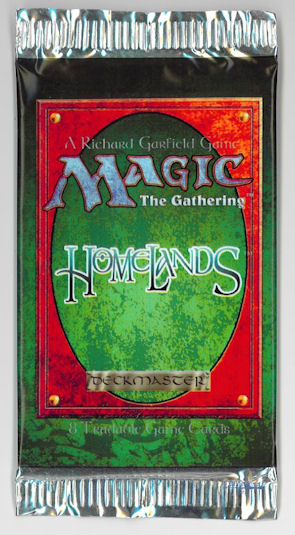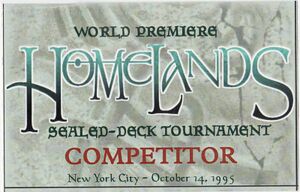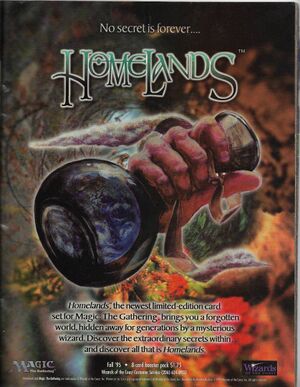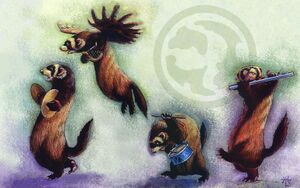Homelands
- This page is about the expansion. For the comic, see Homelands (comic).
| Homelands | |||||
|---|---|---|---|---|---|
| Set Information | |||||
| Set symbol | |||||
| Symbol description | Planet globe | ||||
| Design |
Kyle Namvar Scott "Scooter" Hungerford | ||||
| Development |
Charlie Cantini Skaff Elias Jim Lin Joel Mick Dave Pettey | ||||
| Art direction | Sandra (Everingham) Garavito | ||||
| Release date | October 14, 1995 | ||||
| Plane | Ulgrotha[1] | ||||
| Themes and mechanics | Flavor. creature type tribal, legendary creatures, cantrips | ||||
| Set size |
115 cards (25 commons, 47 uncommons, 43 rares) | ||||
| Expansion code | HML (previously HM)[2] | ||||
| Languages | English, French, German, Italian, Portuguese, Spanish[3] | ||||
| Early non-block expansions | |||||
| |||||
| Magic: The Gathering Chronology | |||||
| |||||
| Scryfall Statistics | |||||
|
115 cards | |||||
Homelands, released in October 1995, is the seventh Magic expansion. It was the second expansion of the Ice Age block until July 2006, when it was removed and Coldsnap was added to the block. Homelands is frequently panned as Magic's all-time low in game design, though it has also been praised for the quality of its setting and flavor.

Set details
Homelands was developed as a separate expansion from the current Ice Age block at the time.[4] The set introduced no new mechanics or keywords but used some of the mechanics of Ice Age, most notably the cantrip ability and single-color legendary creatures. Each color had at least one legend, with some colors having as many as five. The absence of mechanics found throughout the Ice Age block, such as Snow lands and cumulative upkeep, and the fact that it didn't follow the Ice Age block storyline, made it a poor fit in its former block. The expansion symbol of the set is a simplified globe of Ulgrotha, the plane where Homelands was set.[5]
Homelands was printed on 121 card sheets. The set's rarity breakdown is 46 commons (25@C4, 21@C1) and 69 uncommons (26@U3, 43@U1). The U1 are considered the "rares" of the set. Because of the relative number of uncommons to commons in a pack, C1 and U3 cards are of equal rarity despite being printed on different sheets, and are considered the uncommons of the set. Each of the C4 commons has 2 versions of art by the same artist. Most collectors consider these variants to be distinct cards, and therefore a full set to be 140 cards. If the art variants are treated as distinct, there are 71 commons (50@C2, 21@C1).
The Homelands lands have a unique teal-colored text box.
Marketing


Homelands is the last expansion to be printed on only two sheets and sold in eight-card booster packs (two cards from the uncommon sheet and six cards from the common sheet). Each booster bears the same green background image. Homelands was the first simultaneous international release. German, Spanish, French, Portuguese, and Italian versions were being launched around the same time as the English version, and there were release events, called Magic: The Gathering I in New York City, at the Internationale Spieltage SPIEL in Essen, Germany, the Lucca Comics convention in Lucca, Italy, and other locations.
Flavor and storyline
The planeswalker Feroz came across Ulgrotha, the once-beautiful plane now destroyed by the Wizards' Wars. At the last unspoiled oasis on this plane, he met fellow planeswalker Serra, whom he married. Together they worked to restore the plane, and to protect it, Feroz's Ban was created. Later, Feroz died during a lab accident, and the grief-stricken Serra abandoned the plane. In her absence, the isolated civilizations of the plane fight amongst each other while the vampire Baron Sengir plots to take control of the plane under the fading Ban of Feroz.
Short story
| Title | Author | Publishing date | Setting (plane) | Featuring |
|---|---|---|---|---|
| "Song for the Plague Rats" from The Secrets of Magic | Philip Athans | May 2002 | Dominaria | Ravi, Sengir |
Comic
| Title | Author | Publishing date | Setting (plane) | Featuring |
|---|---|---|---|---|
| Homelands* | D. G. Chichester | Feb 1996 | Ulgrotha, Dominaria | Ravi Sengir, Feroz, Sandruu, Borthon, Serra, Cassie An-Havva, Sengir, Hazduhr, Kristina of the Woods, Taysir, Ravidel, Soraya, Angus, Irini Sengir, Bernatheen, Eron, Ihsan, Daria, Reveka, Joven, Chandler, Autumn Willow |
The Duelist
| Title | Author | Publishing date | Setting (plane) | Featuring |
|---|---|---|---|---|
| Issue 7: The Story of Homelands* | Christopher Farris | October 1995 | Ulgrotha | Feroz, Serra, Sandruu, Taysir, Sengir, Eron, Hazduhr, Reveka, Autumn Willow |
| Issue 7: The Slowing of His Heart* | Michael G. Ryan | October 1995 | Ulgrotha | Neth'arna, Thexar, Arras, Jekelth, Pikepierce |
| Issue 8: Eron the Relentless* | Shawn Carnes | December 1995 | Ulgrotha | Eron, Bernatheen, Ravi Sengir |
| Issue 9: Autumn Willow* | Scott Hungerford | February 1996 | Ulgrotha | Autumn Willow, Feroz, Daughters of Autumn, Sengir |
| Issue 10: Baron Sengir* | Scott Hungerford | May 1996 | Ulgrotha | Sengir, Reveka, Veldrane, Autumn Willow, Joven, Chandler, Halina, Eron |
* These are early stories, and may be ignored or contradicted by later stories.
Mechanics and themes
As mentioned, Homelands introduced no new mechanics. It had several themes, including a large number of real-world creature types, clockwork artifact creatures, Legendary creatures, and several "tribal" effects that enhanced only one creature type.
Homelands explored popular characters including Sengir and Serra and had a strong flavor, meaning that the cards were designed to fill specific roles. The flavor text on the cards can also be used to piece together parts of a story.
Creature types

Homelands, like many early expansions, has many creature types that are unique to the creatures they are found on. Many of these are real-world animals and types of people, grounding this expansion more in the real world than other expansions.
There are a few cards in this expansion that reference specific creature types, but most of these are not well supported, often with only one creature in this expansion with the referenced creature type. Those that are referenced are Dwarf, Faerie, Falcon (later changed to Bird), Hero (later changed to Soldier and Warrior), Minotaur, and Vampire. The best-supported creature types were Minotaurs, Dwarves, and Faeries.
The following creature types are introduced in this expansion: Albatross (later changed to Bird), Alchemist (later changed to Cleric), Ambush Party (later changed to Rogue), Autocrat (later changed to Human), Badger, Bureaucrat (later changed to Advisor), Caravan (later changed to Nomad), Carriage (later changed to Horse), Constable (later changed to Human), Crusader (later changed to Knight), Ferret, Folk of An-Havva (later changed to Townsfolk, then Human), Hound (later changed to Dog), Inquisitor (later changed to Cleric), Lizard, Mist (later changed to Elemental), Narwhal (later changed to Whale), Noble (later changed to Faerie), Oyster, Pony (later changed to Horse), and Speaker (later changed to Cleric).
The following creature types are used in this expansion but also appear in previous sets: Bat, Bear, Bodyguard (later changed to Minotaur), Cleric, Dwarf, Faerie, Falcon (later changed to Bird), Fiend (later changed to Horror), Gargoyle, Ghost (later changed to Spirit), Hero (later changed to Soldier or Beast Soldier), Lycanthrope (later changed to Werewolf), Minotaur, Paladin (later changed to Knight), Serpent, Ship (later changed to Pirate), Spider, Troll, and Wolf.
Design and reception
Homelands, on average, had an unexpectedly low power level compared to previously released expansions. The expansion was created, as many of the earlier sets were, without much communication between the designers of various sets. It was made with a flavor-first design philosophy, which, along with its separate storyline, resulted in its strong difference from the Ice Age and Alliances expansions to which it was related in time. This flavor-first design also led to oddities in abilities. For example, many abilities were found in colors that normally do not receive them, such as flying in green or vigilance and trample in black, although this philosophy was not as developed in 1995 as it is today. R&D at the time (Richard Garfield and the East Coast playtesters) didn't want to print the set, but Peter Adkison overruled them because he wanted to keep his promise to the two designers. As a result, the developers didn't put much work into it.[6]
Homelands is widely considered one of the worst Magic sets ever made. Writing for Hipsters of the Coast, Rob Bockman called it "full of profoundly misguided cards".[7] Islandswamp of MTGGoldfish criticized the extremely low power level while praising the flavor and storyline.[8] The set is also considered a failure internally at Wizards of the Coast. Mark Rosewater called it a "poorly designed set" and noted that it taught Wizards the importance of good game design in retaining players.[9]
Cycles
Homelands has one cycle and one partial cycle:
| Cycle name | |||||
|---|---|---|---|---|---|
| Incomplete cantrips cycle | Prophecy | Jinx | Headstone | Renewal | |
| Common cantrip spells. There is no red common cantrip (the only red Homelands spell that allows the caster to draw one card is Winter Sky). | |||||
| Cycle name | |||||
| Tri-color lands | Aysen Abbey | Wizards' School | Castle Sengir | Koskun Keep | An-Havva Township |
| Uncommon lands with " | |||||
Notable cards
- Serrated Arrows saw tournament play not only as a result of the high prevalence of cards like Order of the Ebon Hand in Standard at the time but also because of a short-lived rule requiring constructed tournament decks to include at least five cards from each legal set.
- Merchant Scroll, reprinted in Eighth Edition, is a blue tutor card that remains a passable card in many formats.
- Ihsan's Shade is among the iconic and flavorful legendary creatures of the set and proved difficult to answer with contemporary removal. As a black card it could not be answered with Terror, its Protection protected it from Swords to Plowshares, and its toughness was sufficient to survive Lightning Bolt, while the existence of Dark Ritual made its high mana cost manageable. Other popular legends in the set include Autumn Willow, and Eron the Relentless.
- Memory Lapse, despite being unpopular at first, would go on to become considered one of the best cards in the set.
- Apocalypse Chime was the last expansion-hosing card to be printed.
- Timmerian Fiends was the last card to mention ante.
- At the time of printing, there were only two Vampires in Magic for Baron Sengir to regenerate, neither in the same set; Sengir Vampire (Alpha) and Krovikan Vampire (Ice Age).
Trivia
References
- ↑ Wizards of the Coast. "Dominian FAQ (archived)". wizards.com.
- ↑ Wizards of the Coast (August 02, 2004). "Ask Wizards - August, 2004". magicthegathering.com. Wizards of the Coast. Archived from the original on 2020-11-12.
- ↑ Cards where the set is "homelands" and the cards are any language. Scryfall search. Scryfall.
- ↑ Christopher Ferris (August 22, 2011). "Homelands: The Making of a Magic Expansion". magicthegathering.com. Wizards of the Coast. Archived from the original on 2020-11-12.
- ↑ Brady Dommermuth (October 31, 2006). "Ask Wizards". magicthegathering.com. Wizards of the Coast. Archived from the original on 2021-04-29.
- ↑ Mark Rosewater (January 10, 2014) "Drive to Work #87 - 1995"
- ↑ Rob Bockman (September 25, 2023). "Magic's Worst Real Estate". Hipsters of the Coast.
- ↑ Islandswamp (November 11, 2016). "Magic History: Homelands Insecurity". MTGGoldfish.
- ↑ Mark Rosewater (November 10, 2003). "Make No Mistake". magicthegathering.com. Wizards of the Coast.
